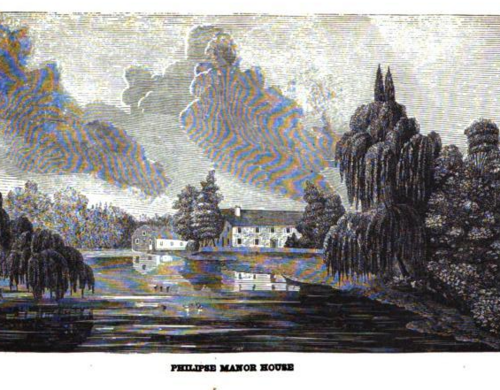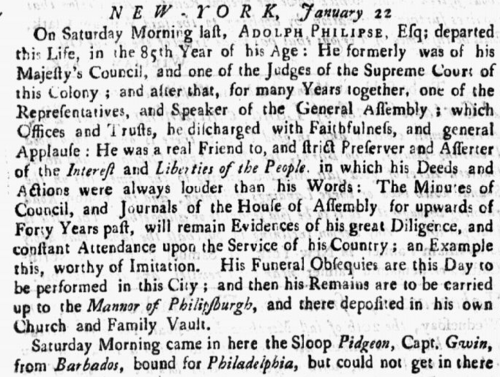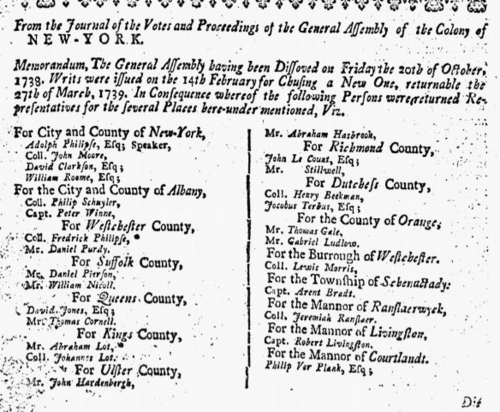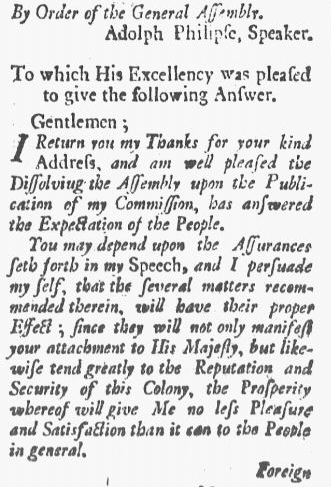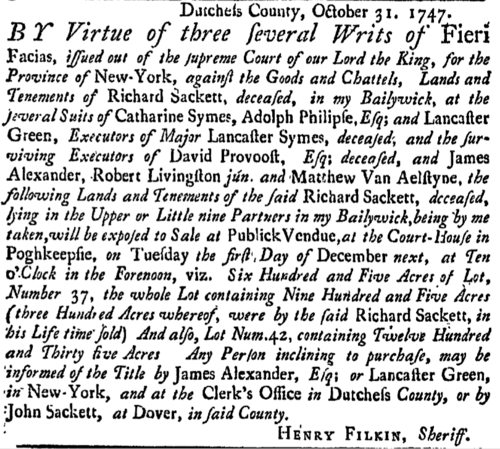Adolph PhilipseFrom The Peopling of New York CityAdolph PhilipseAdolph Philipse was born in 1665 and died in 1750 [1]. He was the son of Frederick Philipse and Margaret Hardenbrook Philipse [2]. He was born in New York but is of dutch descent; his father originally had the name Vrydrych Flypse and changed it when he arrived to New York. Adolph was named after his mother's father, Adolph Hardenbrook, which came from Holland and settled in Bergen County New York [3]. The Philipse Family was one of the wealthiest in all of New York. Frederick originally gained an enormous amount of wealth as a merchant and an active slave trader. Adolph followed his father and also became a merchant and slave trader, although he was not as involved in the slave trade as his father[4]. In addition to being a merchant, Adolph was also a well known politician in New York. Adolph once ran against Cornelius van Horne (the brother of another one of my elusive immigrants, Abraham van Horne) in the Assembly elections. Cornelius van Horne lost to Adolph, 399 votes to 413 votes respectively, but because of great controversy, involving manipulating the votes, an investigation was called for. Eventually Adolph Philipse was declared the victor of the election[5]. In the Assembly Adolph served as city representative and then as Speaker from 1725- 1736 and again from 1739- 1745[6]. Adolph also was a Third Supreme Court Justice in 1712 and held various other political positions in Westchester County[7]. Adolph's father died in 1702 leaving an immense amount of property to his sons. Adolph was the second son and therefore his brother Frederick gained most of the inheritance. Adolph's brother; however, had already died so his inheritance went to his young son, also named Frederick. Since Adolph's nephew was to young to control the vast amount of land, which stretched form northern Manhattan to Westchester County, Adolph acquired complete control of the property. Adolph continued to expand his family's large property by gaining the entire region known as Putnam County[8]. Philipstown in Putnam County is named after Adolph[9]. Philipse never married in his life and mostly tried to better his name by continuously playing a big part in New York City government and expanding his large amount of land[10]. In the 1737 May elections for the Assembly of New York Adolph was presented a challenge that challenged his reputation as a good citizen. Sheriff William Cosby Jr. was widely suspected of rigging the election and forcing everyone to vote for Philipse, from the crippled, the bind, sick, prisoners and the poor[11]. This was a hard blow but Adolph agreed to a recount of the election after many petitioned t review the election. Eventually a committee came to a conclusion that Adolph did deserve to win the election and he remined in the New York Assembly for many more years [12]. I can imagine that Adolph's life was a very fulfilling one because he was able to do so many great things throughout his lifetime. The money that his father had earned gave him the abilities to enjoy his life yet he even expanded on that and earned far more than his father could dream of. He owned 23 slaves of his own and did a little slave trading as well with various trips to the Caribbean throughout his life[13]. Some of Adolph's early encounters as a merchant were very dangerous as he was trying to make as much money as he could with his father. In 1700 they were both accused by the East India Company of violating the company's monopolistic hold on Indian Ocean commerce and of interacting with known pirates, since they did much business with Amsterdam. When one of the family's vessels was seized for violating the English Acts of Trade and Navigation, Adolph was despatched to London to protect the family's interests.[14]. He primary businesses were shipping, wholesaling, and retailing goods to and from Europe and the Caribbean. Unlike his father he did little slave trading, but in other respects his methods greatly resembled his father's and those of other New York merchants [15]. Contemporaries described Philipse as a worldly, convivial, and sophisticated man. Dr. Alexander Hamilton (1712-1756) reported that he met Philipse at the Hungarian Club, whose members were "all bumper men." It was later recorded that he was "said to have been a man of 'superior talents, well educated, sedate, highly respected and popular,' though somewhat penurious"[16]. The obituary that I was able to find, which is the first image underneath, explains what a great person Adolph Philipse was. He was great for New York and he also tried to better himself as much as possible throughout his life.
References
|
